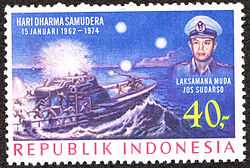Battle of Arafura Sea
| Battle of Arafura Sea | |||||||
|---|---|---|---|---|---|---|---|
| Part of West New Guinea dispute | |||||||
 Indonesian stamp commemorating the Battle of the Arafura Sea | |||||||
| |||||||
| Belligerents | |||||||
|
|
| ||||||
| Commanders and leaders | |||||||
|
Komodor Yos Sudarso Kolonel Sudomo | Unknown | ||||||
| Strength | |||||||
|
RI Matjan Tutul RI Matjan Kumbang RI Harimau |
HNLMS Evertsen HNLMS Kortenaer HNLMS Utrecht supported by a P-2 Neptune plane | ||||||
| Casualties and losses | |||||||
|
Komodor Yos Sudarso Kapten Wiratno (Captain of RI Matjan Tutul) Kapten Memet Sastrawiria (Yos Sudarso aide) Kapten Tjiptadi 21 drowned 53 arrested by the Netherlands | - | ||||||
The Battle of Arafura Sea (Indonesian: Pertempuran Laut Arafura or Pertempuran Laut Aru) or Battle near Vlakke Hoek was an incident in the Vlakke Hoek bay (Etna bay) of the Arafura Sea in Western New Guinea on January 15, 1962 between Indonesia and the Netherlands.
The battle stopped an attempt by the Indonesian Navy to drop off 150 soldiers in Kaimana in Dutch New Guinea for sabotage and to incite the local population against the Dutch government. Commodore Yos Sudarso was in charge of the operation at sea, while colonel Murshid commanded the infiltrants. Three Indonesian torpedo boats left the Aru Islands in the middle of the night but were intercepted near the New Guinea coast by a Dutch Neptune reconnaissance plane, as the Dutch had anticipated the action for weeks. The torpedo boats responded to the flares sent off by the plane by shooting at it. The Dutch frigate HNLMS Evertsen then joined the scene and sank the KRI Macan Tutul, commanded by Sudarso. The other two ships, KRI Macan Kumbang and KRI Harimau, fled, but one hit a reef and the other was disabled by shooting. The Evertsen was able to save most occupants of the Macan Tutul, but at least three sailors died, among whom was commodore Sudarso.[1]
The Indonesian action itself was an abject failure and General Nasution even refused to relay the bad news to Sukarno, forcing colonel Murshid to do this in person.[1] However, the small battle was partially responsible for the subsequent involvement of the Soviet Union and United States in the Western New Guinea dispute,[2] and it is honored in Indonesia by "Sea Sacrifice Day", an annual nation-wide day of remembrance. Twelve years after his death, Yos Sudarso was officially added to the register of Indonesian heroes of the Revolution, while the KRI Harimau was made into a monument at the Purna Bhakti Pertiwi museum in Taman Mini Indonesia Indah.[3]
References
- ↑ 1.0 1.1 Rob Bruins Slot and Gerda Jansen Hendriks, 50 years after the Battle of Vlakke Hoek. Near-war with Indonesia about New Guinea, at www.geschiedenis24.nl (in Dutch)
- ↑ Djiwandono, Soedjati (1996). Konfrontasi Revisited: Indonesia's Foreign Policy Under Soekarno. Jakarta: Centre for Strategic and International Studies. p. 133-5. ISBN 9798026527.
- ↑ "KRI Harimau, Saksi Bisu Pertempuran Laut Aru". 19 March 2012.
Further reading
- "Operation Trikora - Indonesia's Takeover of West New Guinea". Pathfinder: Air Power Development Centre Bulletin (Air Power Development Centre) (150): 1–2. February 2011. Retrieved 19 September 2013.
- Platje, Wies (2001). "Dutch Sigint and the Conflict with Indonesia 1950-62". Intelligence and National Security 16 (1): 285–312. doi:10.1080/714002840.